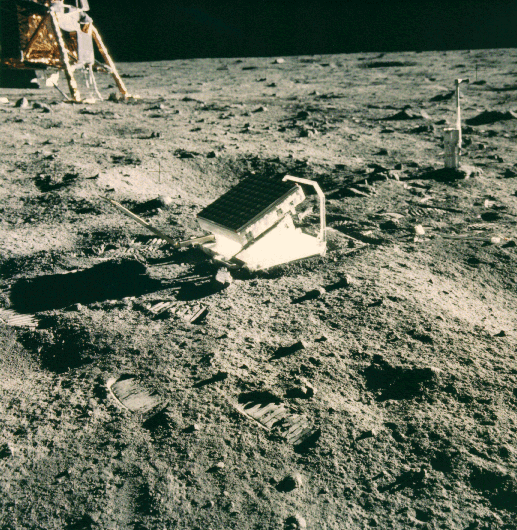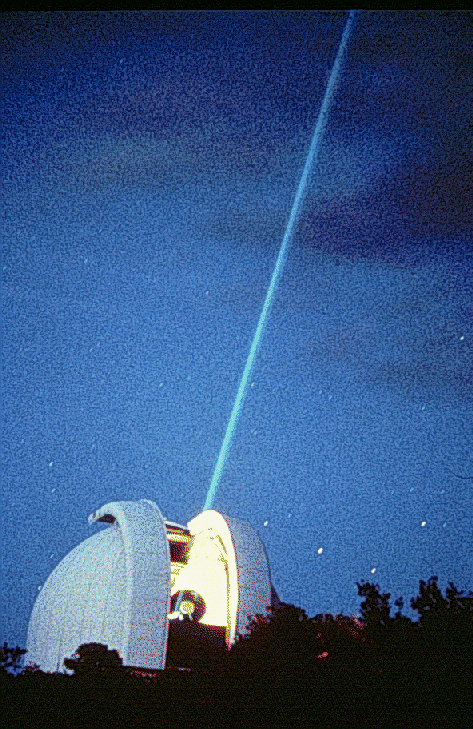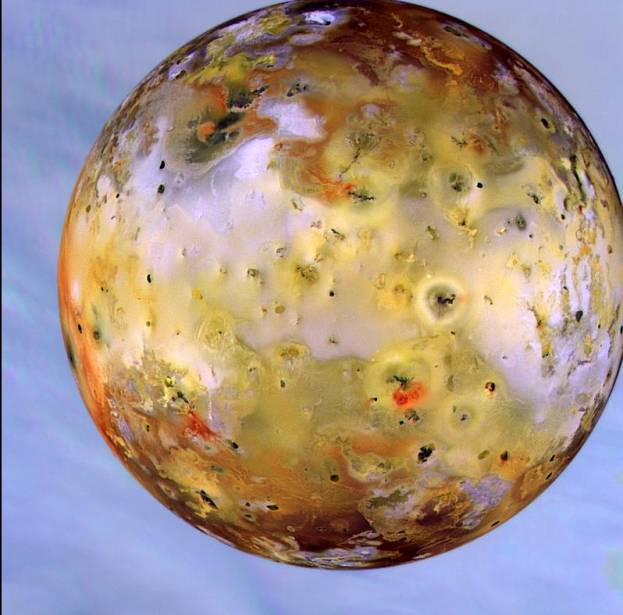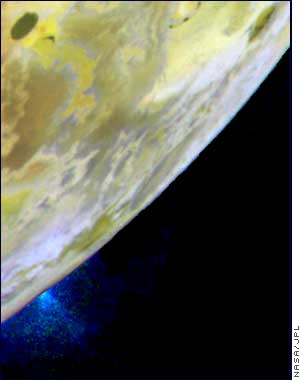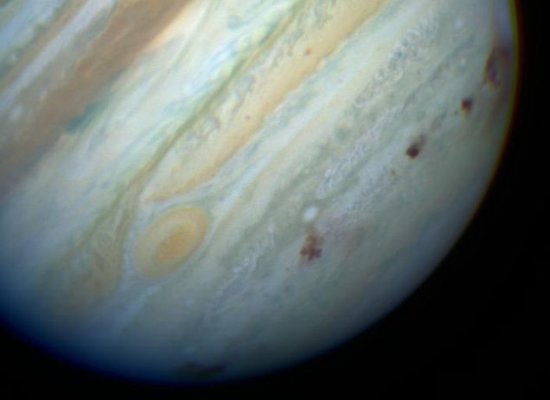Tidal Interactions
Introduction Recall the equation for gravitational force...
This says that gravity gets weaker, the farther two object are from each other. This you already know, but what consequences does this fact have? One is tides. For example...
The Earth and Moon pull on each other, causing them to both orbit around their common center of mass, or balance point. Up to this point we have treated the Earth as a point mass, an object with all its mass at its center, and the Moon the same way. In reality, of course, the Earth is made of many pieces. Let's consider the Earth to be a collection of one-kilogram chunks of rock. The Moon's gravity is pulling on each of these pieces, but — and this is the key point — the Moon pulls more strongly on the pieces of Earth that are closer to the Moon. The diagram below shows this idea, and the result: the Earth (and its oceans) are stretched out along the Earth-Moon line.
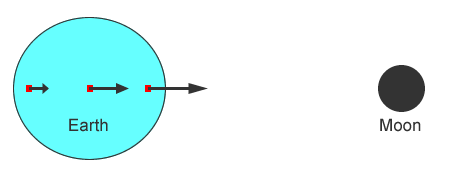
The oceans, being the most fluid part of the Earth, are freer to respond to this differential in force, creating a bulge on the side of the Earth facing the Moon, and also on the opposite side. The diagram above, of course, is not to scale. The average height of the tidal bulge is just a few meters. These bulges stay aligned with the Moon as the Earth rotates; any given coastline, therefore, will hit two bulges (high tides) per day, and two troughs (low tides). Actually, I'm oversimplifying a little there: because the Moon is moving in its orbit around Earth (which takes about four weeks) the average time between high tides is somewhat greater than 12 hours. On average it’s about 12 hours 25 minutes, so high tides do not come at the same time each day. They are synchronized with the Moon’s rising and setting, not the Sun’s.
The Sun also creates ocean tides. Although it is a lot bigger than the moon, the Sun is also much further away --- the tides created by the Sun's gravity are only about 1/3 the height of the Moon-caused tides. Twice a month, at new moon and full moon, the tides caused by the Sun and Moon line up with each other, and we get higher-than-average high tides and lower-than-average low tides. These are called spring tides. (This has nothing to do with the season, but rather the older sense of the word 'spring', to leap up.) On the other hand, at first- and third-quarter moons, when the moon and Sun are 90 degrees from each other in the sky, the Sun's tidal bulge fills in the low-tide portions of the Moon's tides, creating lower-than-average high tides and higher-than-average low tides. These times of the month are called neap tide.
By the way, the tidal interaction between Earth and Moon works in the other direction, too. The Moon is tidally "locked" to the Earth, so it always aims the same hemisphere towards Earth. This is called synchronous rotation (the orbital revolution and spin of the Moon are synchronized.) Tidal interactions also are causing the Moon's orbit to gradually get bigger, at about 3.8 cm per year. The drag of the Earth's rotation actually causes the bulge of the Earth's ocean -- on the moon side -- to be a little ahead of the Earth-Moon line. (Turn on the "include effects of Earth's rotation" option in the first simulation in the right-hand column to visualize this.) The gravity of this mass of water has a slight forward component, kind of like there were a rocket engine pushing the moon gently forward in its orbit. This small but continuous nudge is gradually making the Moon's orbit expand. This expansion can be detected directly with the Lunar Ranging Retroreflector experiments left on the lunar surface at the Apollo 11, 14 and 15 landing sites and also a couple rovers the Soviet Union landed on the Moon in the 1970s.
So far, we've been talking about tides as if they only happen in the Earth's ocean. The solid earth also reacts to the Moon’s stretching action, but its movement is not visible to the casual observer, although it can be detected with instrumentation. Although not important in the case of the Earth, the flexing of a solid body due to tidal forces will heat the solid interior. Tides created by Jupiter's gravity flexes its moons. Jupiter’s moon Io gets enough heat from this process to allow the existence of numerous volcanoes on its surface.
Tidal forces can even be great enough to tear an object apart, as happened to the comet Shoemaker-Levy 9. In 1992 SL-9 had a near-miss, almost hitting Jupiter. The tidal forces from Jupiter were so great that the comet was broken up into 22 large chunks trapped in a 2-year, elongated orbit of the planet. The low point of the orbit intersected Jupiter, and the fragments of SL9 hit the planet in 1994.

Above: Shoemaker-Levy 9 shortly after its discovery in 1993. It had already been broken up by the tidal forces of a very close approach to Jupiter the year before. Below: news footage covering the SL9 collisions.
Below: Jupiter, after the last of the collisions, showing large blemishes in its atmosphere.
Tidal interactions are not confined to the solar system. Binary stars in close orbits are distorted into elongated or even teardrop shapes. Here's a computer animation of what such a system would look like up close.

(Wikimedia Commons/public domain)
In 2010, astronomers using the Hubble Space telescope announced evidence for a planet orbiting so close to its parent star that material from the planet is being stripped. Below is an artist's conception of what it might look like, and here's the press release.
Galaxies that collide into others can leave long streams of stars and gas called tidal tails in their wake. Here's an example, a pair of interacting galaxies called Arp 87, as seen by the Hubble Space Telescope.
Play with this tides simulation applet: http://educypedia.karadimov.info/library/tidesim.swf
Play with this simulation, both with and without the Sun 'on'. When the Sun's tides are included, notice that the difference between the high and low tides is much more dramatic at new and full moons, compared to first and third quarter.
Another sim, including inertial effects. http://kingfish.coastal.edu/marine/Animations/Tides/Tides1.html
The Earth is not stationary as the Moon orbits it. In fact, both the Earth and the Moon orbit their common center of mass. The water on the side of Earth opposite the Moon is 'flung outwards' by its own inertia, just like you feel yourself pushed outwards when you round a curve too fast in a car. As discussed at length when you learned about centripetal force, this so-called centrifugal force is not really a force at all, but is just inertia. The simulation linked above includes this effect, and you can even turn off the gravitational-gradient effect and see just this inertial effect in the animation.
Here's a tide-prediction applet for cities along the Connecticut coast. Have it calculate the tides for a several-month time period and explain what you see. http://www.rvdi.com/tides/
